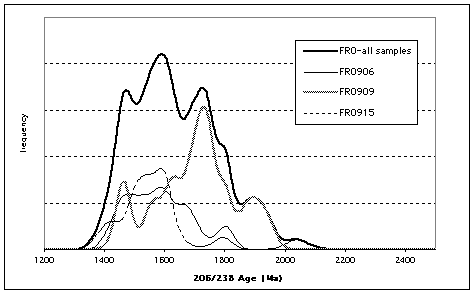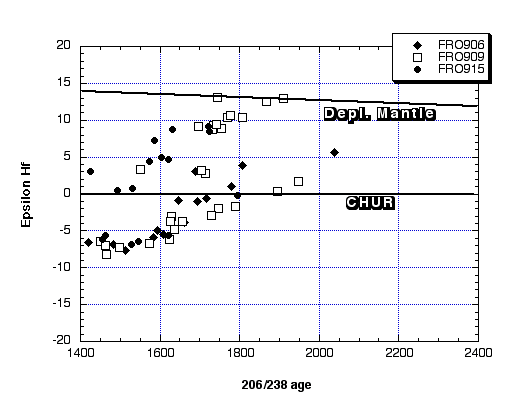INTEGRATED IN-SITU U-PB,
HF-ISOTOPE AND TRACE-ELEMENT ANALYSIS OF DETRITAL ZIRCONS: EVENT SIGNATURES
IN THE PUR-BANERA BELT, RAJASTAN
W.L. Griffin1,2, S.E. Jackson1, E. A. Belousova1 and S. Walters3
-
GEMOC Macquarie
-
CSIRO Exploration and Mining
-
GeoDiscovery Group
U-Pb dating of individual zircon grains from sedimentary rocks to produce
age spectra is a powerful tool for analysing the age distribution of igneous
activity within the source area. However, the application of the technique
to terrane analysis, basin analysis and mineral exploration has been limited
by the high cost of ion microprobe analysis. This barrier has now been
lowered significantly by the application of laser-ablation ICPMS techniques
to obtain precise in-situ U-Pb ages on single grains (typical precision
(2sd) on
206Pb/
238U ages of ±20-30 Ma). The
multi-collector ICPMS with laser-ablation microprobe allows rapid high-precision
analysis of Hf-isotope compositions (±1 ε
Hf)
in the same grains, which provides information on the juvenile vs recycled
nature of the source material of the zircon-bearing igneous rocks. Trace-element
data obtained by EMP analysis (Hf, U, Th, Y) and as a byproduct of the
Hf-isotope analysis (Yb, Lu) can be compared with our large database to
constrain the composition of the source rock for each zircon grain. The
power of this integrated approach is demonstrated in this preliminary report.
Zircon samples were taken from three drainages across the mineralised
Pur-Banera Belt, Rajastan, India. 142 grains (100-300 µm) were examined
by cathodoluminescence/BSE imaging and analysed by EMP. 74 of these were
selected for U-Pb (LAM-ICPMS) and Hf-isotope (MC-ICPMS) analysis. The U-Pb
spectra (Fig. 1) reflect an extended mid-Proterozoic magmatic/metamorphic
event (1900-1400 Ma), similar to that known in parts of Australia. Hf isotope
compositions are bimodal, reflecting both the addition of juvenile material
(εHf
=+ 9 to +14) and recycling of older crust (εHf
= -5 to -10) (Fig. 2).
From 1900-1800 Ma, juvenile additions to the crust were dominant,
while remelting of Paleoproterozoic crust (TDM = 2250-2350) began ca 1700-1800
Ma. During the period 1700-1500 Ma, juvenile material was progressively
mixed with recycled material, with the latter dominating. Igneous rocks
produced from 1400-1500 Ma were derived mainly by recycling of older crustal
components. Trace-element data (Fig. 3) indicate a relatively narrow range
of intermediate to mildly felsic compositions, with little evidence for
the presence of highly evolved granitoids.

Figure 1: Cumulative-frequency curves showing distribution of 206Pb/238U
ages on zircons of three samples.

Figure 2: Epsilon ó age plot for analysed zircons.

Figure 3. Y and U concentrations (EMP) of analysed zircons, overlain
on fields representing compositions of zircons from different rock types
(E.A. Belousova, in prep.)
LAM-ICPMS techniques can produce, rapidly and at relatively low cost,
zircon age spectra with detail equivalent to that obtained by ion-probe
analysis. However, these age spectra in themselves carry limited information
about the actual processes associated with different time intervals. The
integration of in-situ Hf-isotope and trace-element analysis on the same
grains adds significant information on the types and sources of magmatic
rocks, which enhances interpretation of the age spectra. This integrated
approach results in "event signatures" that will be useful in correlation
studies, and in basic research on crustal evolution.




 GEMOC ARC National Key Centre
GEMOC ARC National Key Centre